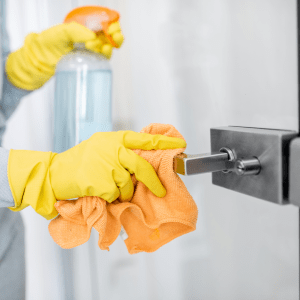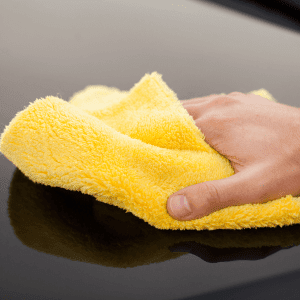Workplace Cleaning for Cold and Flu Season: Essential Products for Infection Control
Cold and flu season returns every year, bringing disruption, staff sickness and lost productivity across UK workplaces. Research shows that an estimated 2.4 million working UK adults could fall ill to seasonal influenza annually, resulting in 4.8 million lost working days. To limit the spread of infection, businesses need
Cold and flu season returns every year, bringing disruption, staff sickness and lost productivity across UK workplaces. Research shows that an estimated 2.4 million working UK adults could fall ill to seasonal influenza annually, resulting in 4.8 million lost working days. To limit the spread of infection, businesses need strong hygiene systems and reliable cleaning products that protect staff, visitors and customers throughout the winter months.
Viruses spread easily in shared workplaces. They transfer through airborne droplets, contaminated hands and high-touch surfaces such as keyboards, handrails, desks, touchscreens and door handles. By increasing hygiene measures, encouraging handwashing and using effective cleaning and disinfection products, workplaces can break the chain of infection before it spreads further.
Below, we explore the most effective products for cold and flu season and how to use them.

–
Cleaning Chemicals
Cleaning chemicals form the base of any workplace hygiene strategy. During cold and flu season, it is vital to clean high-contact surfaces often. Door handles, desks, light switches and shared equipment can all hold viruses for hours if not treated. Cleaning chemicals break down grease, dirt and residue that can trap germs on surfaces.
To use them effectively, apply the product to the surface and wipe with a clean cloth or disposable wiper. Always follow contact times on the label. Offices, schools, healthcare buildings and hospitality settings benefit the most from strict daily cleaning, especially in shared spaces.
2.

–
Disinfectants
After cleaning comes disinfection. A disinfectant is designed to kill viruses, bacteria and pathogens. This is the most important stage for cold and flu infection control. When used after routine cleaning, it offers targeted protection on touchpoints and shared surfaces.
Use disinfectants on desks, phones, rails, keyboards, washrooms, canteens and reception areas. Allow the disinfectant to dwell on the surface before wiping, so it can work against viral particles. Disinfection is especially vital in schools, healthcare environments, offices and gyms, where risk of spread is higher.
3.

–
Paper Products
Paper towels and tissues help reduce the spread of droplets, which are one of the main routes for cold and flu transmission. Encouraging staff and visitors to dry their hands properly and to catch sneezes in disposable paper products can significantly limit contamination.
Place paper towels in washrooms and kitchens. Add tissues in receptions, meeting rooms and shared desks. Paper products support better hygiene habits and reduce cross-contamination risk compared to reusable fabrics.
4.

–
Hand Hygiene Products
Clean hands are one of the strongest defences against cold and flu viruses. Hand hygiene products such as hand soap and sanitisers make it easier for staff to stop germs spreading during the working day. Position them where they have the highest impact: washrooms, kitchen areas, entrances, reception counters and shared workspaces.
Soap and water are ideal for regular hand washing. Hand sanitiser works well between tasks or when staff move between rooms. High-footfall workplaces such as offices, retail, leisure, hospitality and schools should always provide visible hand hygiene stations.
5.

–
Cleaning Equipment
Quality cleaning equipment helps teams work faster and achieve a consistent standard. Microfibre cloths, mops, sprayers and floor cleaning tools remove dirt and reduce the spread of germs on both floors and surfaces. Microfibre is especially useful, as its fibres lift and trap fine particles that can hold viral droplets.
Use colour-coded cloths and mops to avoid cross-contamination between areas such as washrooms, kitchens and general spaces. This improves hygiene control and supports professional cleaning standards in offices, schools, healthcare facilities and commercial venues.
6.

–
Bins & Waste Management
Waste disposal is often overlooked but plays a major role in preventing the spread of cold and flu. Tissues, paper towels and food waste can release germs back into the air if not contained. Using smart bin systems with lids and frequent emptying keeps germs away from shared areas.
Place bins in washrooms, hallways and entrances, and always pair them with hand hygiene points. This encourages responsible disposal and maintains a cleaner environment throughout the day.
Our Latest News
View newsWorkplace Cleaning for Cold and Flu Season: Essential Products for Infection Control
Cold and flu season returns every year, bringing disruption, staff sickness and lost productivity across UK workplaces. Research shows that
View articleAutumn Leaf Fall: Gutter, Drain & Exterior Cleaning for UK Businesses
As autumn arrives in the UK, falling leaves create more than just picturesque scenery, they can cause real problems for
View articleAutumn Air Quality: Ventilation & Odour Control Tips
As autumn begins and nights are getting colder, most buildings gradually close their windows and doors. However, this simple shift
View article